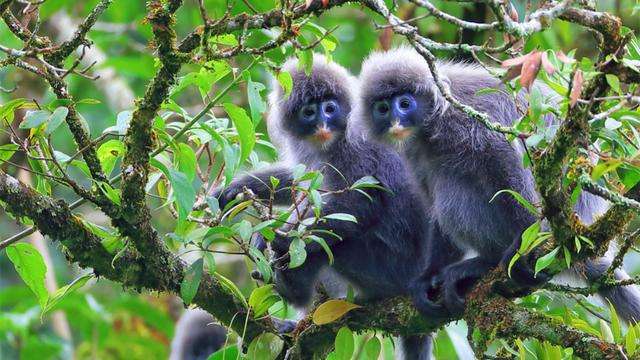Trachypithecus phayrei
IUCN
LCBasic Information
Scientific classification
- name:Trachypithecus phayrei
- Scientific Name:Phayre’s langur, Gray monkey, long-tailed monkey, Philippine leaf monkey, French leaf monkey
- Outline:Primates
- Family:Primates Cercopithecidae Trachypithecus
Vital signs
- length:55-71cm
- Weight:5.6-9kg
- lifetime:20year
Feature
"Melancholy" blue eyes attract people's pity
Distribution and Habitat
Distributed in Bangladesh, India (Assam, Mizoram, Tripura) and Myanmar.
In China, it is distributed in Yunnan Nanjian, Mengyang, Menglong, Menghun, Mengwang, Jinghong, Gengma, Yingjiang, Mengla, Mengbang, Jingdong, Xinping (Ailao Mountain), Menglian, Hekou, Pingbian, Cangyuan, Baoshan, Luxi, Tengchong, Jinping, Luchun, Jianshui, Mengzhe, Yiwu, Wenshan, Malipo, Maguan, Yuanjiang, Gongshan, Fugong, Lushui, Yunlong and other places.
It mainly inhabits tropical rainforests, monsoon forests or subtropical evergreen broad-leaved forests below 1500m on both sides of rivers and low mountain valleys.
Appearance
Phyllis langurs are larger. The body length is 55-71 cm, the tail length is 60-80 cm, and the weight is 5600-9000 grams. The head of the head has upright, pointed cone-shaped tufted pappus, which is longer. The hair on the top of the head is light silvery gray. There are no cheek pouches, the cheeks are black, and there are black hairs between the eyebrows. With white eye rings and mouth rings. The upper and lower lips and around the eyes are pale. The limbs are slender, the front and rear feet are narrow and long, the big toe is short and the other toes are slender; the hip calluses are not well developed. The whole body is silvery gray or slightly yellow, shiny; the coat is thick and sparse, with less fluff. The tail, feet and back of the body are the same color and slightly lighter than the back. The fur color on the ventral side is lighter than that on the back, light gray or light white. The tail is significantly longer than the head and body. Except for the slight black at the en
Details
Philippine leaf monkeys are typical arboreal leaf monkeys in tropical and subtropical Southeast Asia. There are two subspecies: Philippine leaf monkey nominate subspecies and Philippine leaf monkey subspecies Yunnan.

The activities, foraging and playing of Philippine leaf monkeys are mostly carried out in trees, but they also often go to ground ponds to drink water. The population size is about 50-60, and it is a polygamous polygamous system. The daily activities mostly start around dawn, and 9-12 am is the peak period for Philippine leaf monkeys to eat and live frequently. They take a nap at noon (12-13 o'clock), often playing or sitting quietly on trees. There is another peak of activity from 16-19 o'clock in the afternoon. When it gets dark, they choose to sleep in tall trees with dense branches and sheltered from the wind nearby. In Xishuangbanna, southern Yunnan, China, the territory of the Philippine leaf monkey group is about 77-81 hectares. Females consciously spread out from the family group, while males mainly stay in the original territory (philopatric: attachment to the original birthplace). Females show a linear dominance hierarchy, and it seems that they like to fight for food more than imagined.
The distribution range of Philippine leaf monkeys in China is only slightly smaller than that of black leaf monkeys. The population size was estimated in the early 1980s: there are 10,000-15,000 individuals in the southern Yunnan subspecies; there are 1,500-2,000 individuals in the western Yunnan subspecies. The deforestation and reduction of tropical and subtropical virgin forests are the main factors causing the decline in the number of Philippine leaf monkeys. Except for some zoos that have kept a small number of them, there has been almost no large-scale breeding. There are more than 10 nature reserves in Yunnan (Xishuangban Nature Reserve, Luchun Huanglianshan Nature Reserve, Pingbian Daweishan Nature Reserve, Jinping Fenshuiling Nature Reserve, Malipo Laojunshan Nature Reserve, Nanjian Wuliangshan Nature Reserve, Jingdong Wuliangshan Nature Reserve, Xinping Ailaoshan Nature Reserve, Lincang Daxueshan Nature Reserve, Cangyuan Nangunhe Nature Reserve, Yingjiang Tongbiguan Nature Reserve and Gaoligongshan Nature Reserve) to protect Philippine leaf monkeys. Most of these reserves were established between 1980 and 1986, all of which are national and provincial nature reserves, with a total area of about 536,000 hectares. Since the establishment of the reserve, the habitat of Philippine leaf monkeys has been protected; in addition, due to publicity and strict law enforcement, the public's awareness of protection has been improved, and poaching of Philippine leaf monkeys inside and outside the reserve has been basically stopped.
Listed in the IUCN Red List of Threatened Species in 2015 ver3.1 - Least Concern (LC).
Listed in Appendix I, II and III of the Convention on International Trade in Endangered Species of Wild Fauna and Flora (CITES) 2019 edition Appendix II.
Listed in the first level of China's National List of Key Protected Wildlife on February 25, 2021.
Protect wildlife and eliminate game.
Maintaining ecological balance is everyone's responsibility!








